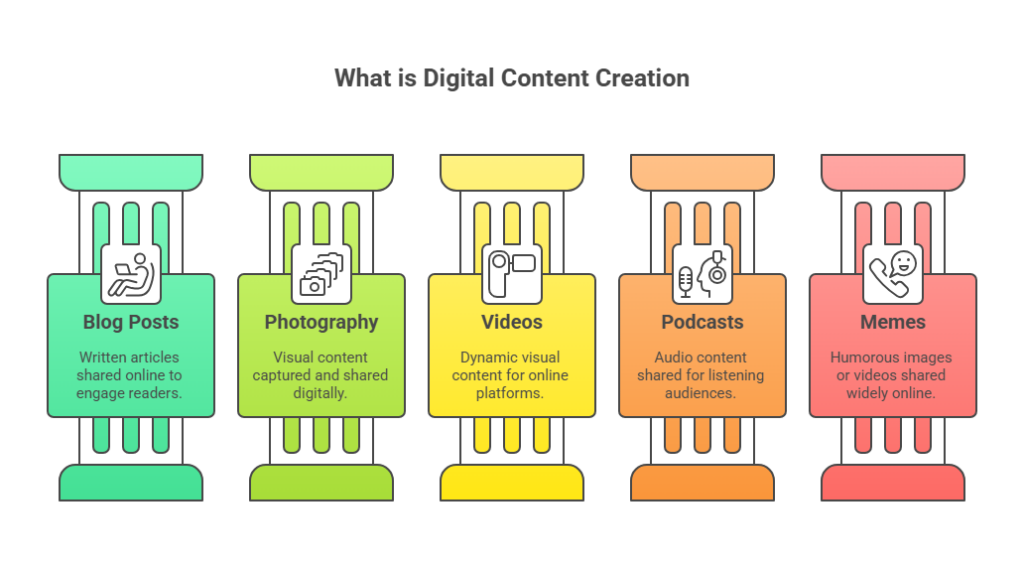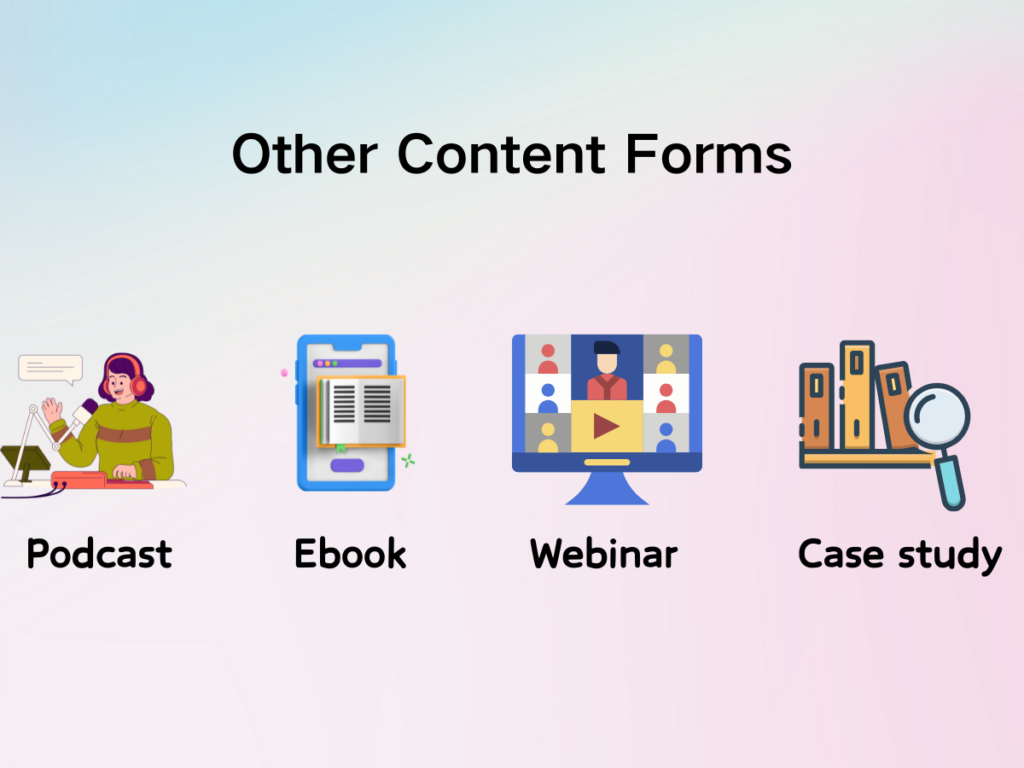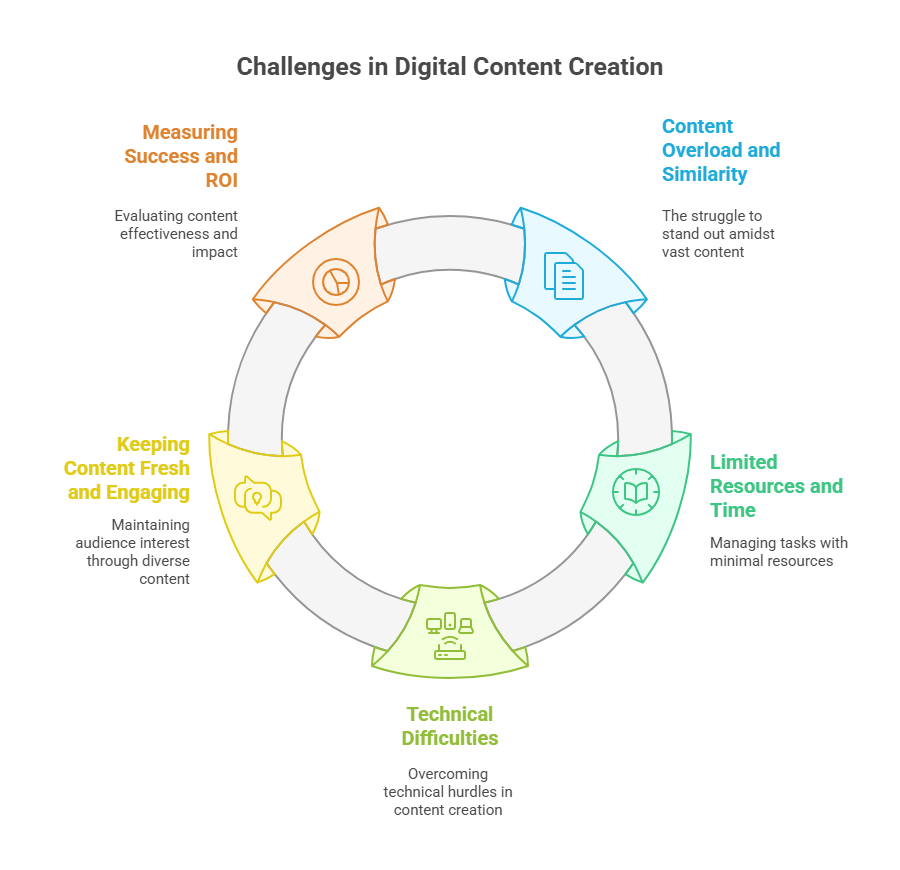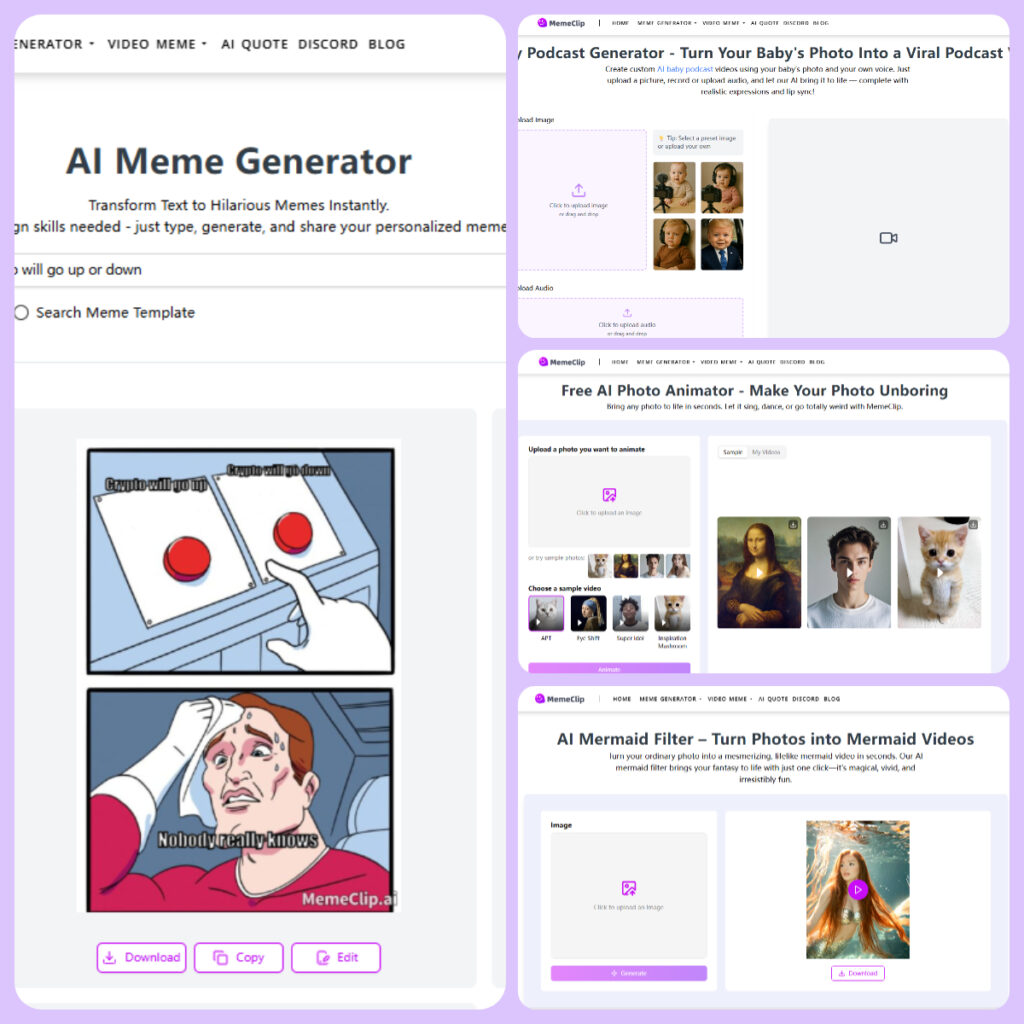
"The best marketing doesn't feel like marketing." – Tom Fishburne
A few years ago, Rachel, a freelance designer, struggled to get clients. She had skills, passion, and drive — but nobody knew about her. One day, she started writing short blog posts on LinkedIn, posting design tips on Instagram, and sharing quick videos of her creative process on TikTok. Within 6 months, she had a waitlist.
What changed?She mastered content creation.Today, whether you're an entrepreneur, a small business, or a content creator, knowing how to create digital content is no longer optional — it’s essential.
Let’s explore what digital content creation really means, why it matters, and how to do it well (without burning out).And in this article, I’ll also show you how AI is making content creation way easier. With tools like MemeClip, anyone can whip up something fast, funny, and ready to go viral.
What Is Digital Content Creation?
Let’s keep it simple.
Digital content creation means making anything you can share online. This includes writing blog posts, taking photos, shooting videos, recording podcasts, and even designing memes. If you can upload it, click it, or stream it—it’s digital content.
But it’s not just about creating for fun. In today’s world, content is how brands talk to their audience. Think about it: your website copy, Instagram reels, YouTube tutorials, LinkedIn updates—all of that is part of your digital presence. And someone has to create it.
Whether you're a small business showing off a new product or a freelancer building your personal brand, digital content creation is your main way to get noticed.
Why It’s More Than Just “Posting Online”
Digital content creation is the backbone of modern marketing. Without it, there’s no engagement, no awareness, and definitely no conversions.
Let’s break it down:
- When you publish a blog post, you're helping people find your site through search engines.
- When you post a meme on Twitter, you're giving your brand a human voice.
- When you upload a product video, you're building trust with potential buyers.
Every piece of content tells a story. And each story brings you closer to your audience.
It’s Also a Business Skill Now
Once upon a time, content creation was for writers, designers, and videographers. Now? Everyone's doing it.
Real estate agents are making TikToks. Doctors run YouTube channels. Small business owners run their own Instagram pages. Digital content creation is now a must-have skill for anyone who wants to grow online.
Even job seekers use it. Posting smart content on LinkedIn can help you land a job faster than submitting 100 résumés.

Why Digital Content Creation Matters
So, why should you care about making content? Because in the digital world, if you're not seen, you don’t exist.
1. It Builds Brand Awareness
Let’s look at the facts. According to HubSpot, businesses that blog get 55% more website visitors than those that don’t. That’s not a small bump. That’s a big fat "hello, world" from Google search.
The more content you create, the more people find you. Simple as that.
Want proof? Take a look at Duolingo. They turned a green owl into a TikTok celebrity using funny, weird, and wildly creative videos. Now millions of people know them—not just as a language app, but as a brand with personality.
2. It Boosts Engagement
Digital content creation helps you talk with your audience—not just at them. Memes, videos, comments, stories—they’re all ways to start conversations.
People are 10x more likely to engage with content that feels real. That means:
Funny memes > Boring sales pitch
Behind-the-scenes video > Formal product photo
Honest blog post > Generic ad copy
Engagement isn’t just about likes. It’s about building a community that sticks around.
3. It Builds Trust
Let’s be real—no one trusts ads anymore. But they do trust content.
If someone reads your blog post and learns something useful, that builds trust. If they see your behind-the-scenes reel and laugh, that builds connection. If you share stories from your journey, people relate.
Content is how you turn strangers into fans.
And guess what? Consistent digital content creation can generate 3x more leads than traditional marketing, according to DemandMetric. And it costs 62% less.
4. It Drives Traffic and Sales
Creating smart content isn’t just about being popular—it’s about being profitable.
Let’s say you write a great guide and publish it on your website. If it’s optimized for SEO, it can bring you visitors for months, even years. That’s free traffic. And some of those visitors become customers.
Same goes for videos. A single viral video can lead to thousands of new followers. And even better—more sales.
5. It Supports Your Whole Marketing Strategy
Social media? You need content.
Email campaigns? You need content.
Ad funnels? You guessed it—content.
Think of digital content creation as the fuel for everything you do in marketing. Without it, your campaigns run dry.
Not all content is created equal. Different goals need different types of digital content creation. Let’s walk through the most popular ones—and how you can use them.

Common Types of Digital Content
1. Blog Posts
Yes, the good old blog still works. Really well.
If you're trying to drive traffic to your website, educate your audience, and build authority, blog posts are your best friend. According to DemandMetric, companies that blog generate 67% more leads per month than those that don’t.
But don’t write like a robot. Use a friendly tone, keep it clear, and answer real questions your audience has. That’s the heart of good digital content creation.
Pro Tip: Use tools like Semrush or AnswerThePublic to find blog topics people actually search for.
2. Social Media Posts
Short, fast, and fun—social content is made to be shared.
This includes:
- Tweets
- Instagram posts and stories
- Facebook updates
- LinkedIn content
- TikToks
- Reels
The key? Make it visual, make it personal, or make it hilarious. Better yet, do all three.
Meme formats work especially well here—and that’s where MemeClip comes in handy. Just add your message, and boom—you’ve got a shareable meme in seconds. This kind of visual storytelling is a smart part of digital content creation today.
3. Videos (Short + Long)
Video content is the king of engagement. In fact, Wyzowl reports that 91% of businesses now use video as a marketing tool. And it’s not just long YouTube videos anymore.
Short-form content is exploding:
- TikTok
- YouTube Shorts
- Instagram Reels
- Facebook Stories
Even B2B companies are jumping in. Why? Because people watch videos more than they read. And when done right, video builds trust faster than any other format.
Blendtec’s “Will it Blend?” videos turned a boring blender brand into a viral sensation—with millions of views and a big bump in sales. A perfect case of strategic digital content creation at work.

4. Infographics and Image Content
Got data or step-by-step info to share? Use an infographic. They turn boring numbers into eye candy.
According to Venngage, infographics are 30 times more likely to be read than plain text. Plus, they’re great for Pinterest, LinkedIn, and blog posts.
Images, GIFs, and memes also play a big role. They add emotion, tone, and personality to your brand. Visual content like this should be a regular part of your digital content creation toolkit.
5. Email Content
Emails may be old-school, but they still bring the highest ROI among marketing channels—around $42 for every $1 spent (Litmus, 2023).
But here’s the thing: no one wants to read a boring newsletter.
Use content like:
- Weekly tips
- Short memes
- Quick videos
- Personal stories
Make it feel like a friend wrote it. Not a robot. Effective email writing is still a vital piece of smart digital content creation.
6. Other Content Forms
Depending on your brand and audience, you might also explore:
- Podcasts – for deep dives and loyal listeners
- Ebooks – for lead generation and authority building
- Webinars – for interactive teaching and community
- Case studies – for credibility and sales support
Each type plays a unique role in the wider world of digital content creation. You don’t have to do them all—just pick the ones that make sense for your goals and resources.

The Digital Content Creation Process
Creating digital content isn’t just about sitting down and making something. It takes planning, strategy, and follow-through. Here’s a simple step-by-step process to help you master it.
Step 1: Planning and Strategy
Before you create anything, ask yourself:
Who is my audience?
What do they want or need?
What is my goal with this content?
Understanding your audience means knowing their age, interests, problems, and where they hang out online. For example, teenagers might be on TikTok, while professionals prefer LinkedIn.
Next, set clear goals. Are you trying to get more followers? Drive sales? Increase website visits? Your goal will guide your content type and style.
Then, create a content calendar. This is a schedule of what you will post and when. It helps keep you organized and consistent. Consistency is key to building trust and engagement.
Step 2: Content Creation
Now, it’s time to produce your content.
Writing: Draft blog posts, social media captions, or emails. Keep language simple and clear.
Designing: Create images, infographics, or memes. You don’t need to be a pro designer—tools like MemeClip can help you make professional memes and videos quickly.
Recording: Film videos or record audio. Keep your equipment simple. Even a smartphone can deliver great results.
Remember, quality matters, but don’t aim for perfection on the first try. Get it done and improve over time.
Step 3: Publishing and Distribution
Choose the right platforms for your content. Not every content fits every platform. For example:
Blogs go on your website.
Short videos work best on TikTok or Instagram Reels.
Professional articles belong on LinkedIn.
Share your content actively. Post, repost, and engage with your audience’s comments.
Step 4: Monitoring and Optimization
Once your content is out, watch how it performs. Use tools like Google Analytics, Facebook Insights, or Instagram Analytics to check views, likes, shares, and comments.
Ask yourself:
What content worked best?
What didn’t perform well?
How can I improve next time?
Based on this data, adjust your strategy and keep learning.

Challenges in Digital Content Creation
Creating digital content sounds fun, but it’s not always easy. Many creators face common problems. Knowing these challenges helps you prepare and avoid pitfalls.
1. Content Overload and Similarity
There is so much content out there. Millions of blogs, videos, and posts every day. This can make your work feel lost or repetitive.
Standing out means being unique. Copying others won’t help you. You need your own voice and style. This is why fresh ideas and creativity matter.
2. Limited Resources and Time
Not everyone has a big budget or a full team. Many creators do everything themselves—writing, filming, editing, and posting.
This can be stressful and exhausting. Time management and prioritizing important tasks become essential.
Tools like MemeClip can save you time by quickly generating quality memes and videos, so you focus on strategy and creativity.
3. Technical Difficulties
Creating digital content involves many skills:
Graphic design
Video editing
SEO writing
Platform management
If you’re new, it’s easy to get overwhelmed by all the software and platforms.
Learning gradually and using user-friendly tools can reduce this stress.
4. Keeping Content Fresh and Engaging
Posting regularly is key, but repeating the same ideas can bore your audience.
Mix up your content types—blogs, memes, videos—and experiment with new formats.
Follow trends but make sure they fit your brand. Using an AI tool like MemeClip can help you create timely and fun memes that resonate.
5. Measuring Success and ROI
Sometimes it’s hard to tell if your content works. Likes and shares are nice, but do they bring sales or new customers?
Set clear goals and track the right metrics. Use analytics to learn and adjust your content plan.

How AI Is Changing Digital Content Creation
AI is no longer science fiction—it’s now a powerful helper for digital content creation.
1. Faster Content Production
AI tools can generate drafts, captions, images, and even videos quickly. This saves hours of work and speeds up the digital content creation process.
For example, instead of spending days designing memes, you can use AI-powered platforms like MemeClip to create them in seconds.
2. Boosting Creativity
Sometimes creative blocks happen to everyone. AI can suggest ideas, provide templates, or remix content, helping you get unstuck.
Think of AI as a brainstorming partner who never runs out of energy.
3. Personalized Content
AI can analyze user behavior and preferences. This means you can deliver content tailored to each audience segment.
Personalization improves engagement and makes your messages more relevant.
4. Optimizing Performance
AI tools can analyze data faster and recommend the best times to post, which keywords to use, and what content style works best.
This helps you make smarter decisions and improve your results.
5. Democratizing Content Creation
Before AI, creating high-quality digital content creation often required expensive software and expert skills. Now, AI lowers the barriers.
Anyone—from small business owners to solo creators—can join the game without a big budget.

MemeClip: Revolutionizing Digital Content Creation
Let’s face it—creating content all the time is exhausting. Social media wants fresh posts, your blog needs updates, and your audience? They expect magic. Every. Single. Day.
Instead of spending hours designing or brainstorming your next viral moment, MemeClip helps you turn ideas into scroll-stopping memes and short videos in seconds. No design degree required, just your message and a few clicks.
Whether you’re a brand trying to stay top-of-mind or a marketer juggling ten platforms, this little boost in your digital content creation flow makes a big difference. More speed, more creativity, and way less stress.
It’s like having a meme team in your pocket—ready whenever inspiration (or a deadline) hits.

Conclusion
Digital content creation is more than a trend—it’s how brands connect with people today. In a noisy online world, content is how we show up and get remembered.
Creating content daily isn’t easy. It takes time, effort, and fresh ideas. That’s why mastering digital content creation with smart tools is a must.
AI tools don’t replace creativity—they boost it. MemeClip saves time and turns your ideas into memes and visuals that speak the internet’s language.
Whether you’re building a brand or launching a project, the digital world rewards those who create with purpose, personality, and help from technology.
Now it’s your move. What will you create next?
-1-1024x724__2d73320374fec118ecacdc8a76789d9d__2d73320374fec118ecacdc8a76789d9d.png)